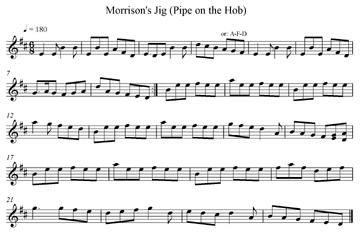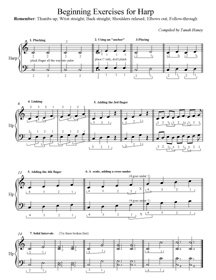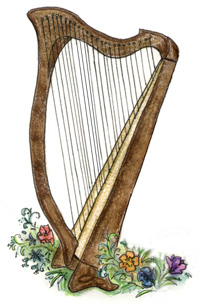Sorry for the long wait between posts, I was away all this weekend visiting with old friends.
Since so many harpists are fans of Celtic music, a lot of them are interested in jams and ceilis – what they are, how a harpist can participate, and so on. So this will be the first in a series of posts about that very topic. I’ve already got a fairly detailed look at Celtic Jams and Sessions up on the Celtic Harp Page, but I will go into each in a bit more depth here. To start with….
What are Celtic jams, sessions (or “sesiuns”) and ceilis (or ceilidhes)? Aren’t they all the same thing?
Some people use the terms interchangeably (you’ve probably heard the term “jam session”), however some trad musicians distinguish between the various terms. To most of the trad musicians I know, a jam is more of a free-for-all, where new people may show up not already knowing the tunes, but willing to just pick out chords and such on the fly. Often someone will suggest (i.e. shout out) a tune or set, and launch right into it, and everyone who wants to join in does. Quiet instruments and beginners might find the pace a bit breathtaking, and may feel overwhelmed at first. Part of the problem is that you don’t always know what to expect – some days you might show up to find you’re competing with three fiddles, two guitars, an accordion and four bodhran players (of varying skill levels). Singers and harp players may only get to be heard while everyone else is taking a beer break. In these cases, it helps to attend a few jams just as observer, and if possible to find someone to write down a list of common tunes for you (if you’re really lucky, you might even get someone to copy some sheet music for you). Generally, jams are part of the true oral tradition, in that you play by ear (memory). However, at our Sunday Celtic Jam here in Peterborough, no one minds if people drag their music stand along, and it’s quite common to see several battered copies of the Fiddler’s FakeBook in use on any given Sunday. It’s usually best to talk to the local jam’s organizer first to get the lay of the land (we’ll be looking at jam/session “etiquette” later on.)
A session (or sessiun), on the other hand, may be somewhat more organized, or even more “elite”. Often it is an established group of players who all know the same tunes, and can play them consistently at or above a certain skill level. Session players may meet regularly to learn new tunes, but when performing are expected to be able to lead or follow without getting lost, and to be familiar with the types of sets typical for that group (e.g., for a reel set, someone may call out a familiar set of reels in G major; a “set” is just several tunes strung together, played one right after the other). If you want to join an established session group, likely there will be a group leader you can talk to. They may send you home with sheet music or a tape or CD to learn from, and expect you to show up at the next session (or practice) with at least some of the tunes already learned (generally, this means by memory – Celtic session musicians do not usually use sheet music for performing, although it may be used for learning the tunes initially). However, some people might refer to any impromptu gathering of musicians as a “session” (there can be other kinds of sessions too – bluegrass, blues, jazz, old-timey tunes, folk music, you name it). As above, it’s good to ask the local organizer or a veteran player if you’re not sure.
A ceili (or ceilidhe) differs notably from a jam or session in that it is often intended to accompany dancing (although some people will use the term “ceili” to mean a jam/session, or even just any party or get-together where music is played – just to confuse the issue!). In some ways, a ceili (the kind for dancing) is similar to a session, but may be even more restrictive in terms of who is allowed to play, and what they’re expected to know. If you want to play for a ceili, you’ll need to familiarize yourself with all the traditional time signatures and tune types – e.g. reel, jig, strathspey, slip jig, polka, waltz, etc. In a Ceili, usually the caller (the person calling out dances) will lead, and give indication to the band what tunes are needed. Often the tunes will be done in sets of 2 to 4 tunes at one time, sometimes in the same key, but often switching keys or going into relative minors or majors of that key. For a harp player, this can be a bit tricky, but usually you can get away with it by using, say, the first (“A”) part of a tune to flip levers, and coming in on the repeat. As a harp, keyboard, or guitar player, if you’re invited to play for a ceili even though you may not know all the tunes, you will be expected to have some proficiency in picking out chord patterns to accompany the tune. If you’re a drummer, you will be expected to know the typical rhythm patters, and you must be precise in your timing, so as not to throw off the dancers or the other musicians. Some local Ceilis happen on a regular basis (e.g. once a month), and are open to any local musician (with outsiders being considered guests; it’s usually best if you’re invited by a local). Just keep in mind, that while at jams you are just there to play music and have fun, at a dance ceili you’re actually performing a function – keeping the dancers happy and energized, as well as pleasing the audience. This doesn’t prevent it from being loads of fun, of course! But they will expect you to be in tune and know your stuff.
Here’s a short jam/session newbie checklist:
1. Know Your Chords – It really, really helps to know how to play basic chords, and to know your key signatures. To practice, FakeBooks or other collections of lead-sheet music (melody line and chord markings) are great. Playing along with CD’s or DVD’s can also be helpful, as it should give you an idea of what it’s like to play with people going full speed.
2. Have a Way to Tune Your Harp in a Loud, Crowded Room – You’ll want to tune your harp perfectly before you go to your local jam, but as we all know harps don’t always want to stay in tune, especially if they’ve gone from house to car to unfamiliar location. It helps to arrive early to let the harp get adjusted to its new environment. For tuning when there’s lots of background noise, bring an electronic tuner and a pickup. Tuning by ear is a great skill to have, but won’t help you much when you can’t hear yourself! If hearing yourself is really an issue (you should at least be able to hear yourself a little while playing), then you might want to ask if it’s okay to bring a small amp. Some groups are okay with this, but in some places it’s completely taboo, so check first!
3. Know Your Local Group – Every regional group operates in its own, unique way. Talk to the organizer, talk to some regular participants. Most regular session players are friendly and helpful, and should be able to tell you all you need to know (such as, what playing level they expect you to be at, how fast it goes, how big the group is, if it’s okay to bring music and/or amplification, and so on).
4. Bring Your Own Stuff to Play! – People actually like taking a break from the rousing jigs and reels to listen to an occasional slow air. Bring a few favourites already memorized, and your audience will usually love it. The fast players can use this as an excuse to grab a beer or go out for a smoke, but you may be surprised at how many people stick around to listen. Harps are enchanting after all, and have an old, rich tradition in Celtic culture.
5. Don’t Give Up! – It may seem fast and furious at first, but don’t worry – if you get good at chording along to tunes, you should be able to start by picking out simple bass lines, then progress to more elabourate chords and rythms, and then on to counter melodies and harmonies. If the regulars don’t mind, you can bring a tape or digital recorder and record each session, then practice playing along at home. If you can find a tune list and sheet music, or if you’re good at picking up stuff by ear, you can gradually learn to play along with the melody lines as well. Consistent fingering helps to play those really fast tunes.



